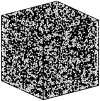A Particle Model for Prediction of Cement Infiltration of Cancellous Bone in Osteoporotic Bone Augmentation
- PMID: 23840794
- PMCID: PMC3693961
- DOI: 10.1371/journal.pone.0067958
A Particle Model for Prediction of Cement Infiltration of Cancellous Bone in Osteoporotic Bone Augmentation
Abstract
Femoroplasty is a potential preventive treatment for osteoporotic hip fractures. It involves augmenting mechanical properties of the femur by injecting Polymethylmethacrylate (PMMA) bone cement. To reduce the risks involved and maximize the outcome, however, the procedure needs to be carefully planned and executed. An important part of the planning system is predicting infiltration of cement into the porous medium of cancellous bone. We used the method of Smoothed Particle Hydrodynamics (SPH) to model the flow of PMMA inside porous media. We modified the standard formulation of SPH to incorporate the extreme viscosities associated with bone cement. Darcy creeping flow of fluids through isotropic porous media was simulated and the results were compared with those reported in the literature. Further validation involved injecting PMMA cement inside porous foam blocks - osteoporotic cancellous bone surrogates - and simulating the injections using our proposed SPH model. Millimeter accuracy was obtained in comparing the simulated and actual cement shapes. Also, strong correlations were found between the simulated and the experimental data of spreading distance (R(2) = 0.86) and normalized pressure (R(2) = 0.90). Results suggest that the proposed model is suitable for use in an osteoporotic femoral augmentation planning framework.
Conflict of interest statement
Figures












References
-
- Lane J, Russell L, Khan S (2000) Osteoporosis. Clin Orthop Relat Res 372: 139–50. - PubMed
-
- Beckmann J, Ferguson S, Gebauer M, Luering C, Gasser B, et al. (2007) Femoroplasty – augmentation of the proximal femur with a composite bone cement – feasibility, biomechanical properties and osteosynthesis potential. Med Eng Phys 29: 755–64. - PubMed
-
- Heini PF, Franz T, Fankhauser C, Gasser B, Ganz R (2004) Femoroplasty-augmentation of mechanical properties in the osteoporotic proximal femur: a biomechanical investigation of PMMA reinforcement in cadaver bones. Clin Biomech 19: 506–12. - PubMed
-
- Beckmann J, Springorum R, Vettorazzi E, Bachmeier S, Luring C, et al. (2011) Fracture prevention by femoroplasty – cement augmentation of the proximal femur. J Orthop Res 29: 1753–8. - PubMed
Publication types
MeSH terms
Substances
Grants and funding
LinkOut - more resources
Full Text Sources
Other Literature Sources
Medical

